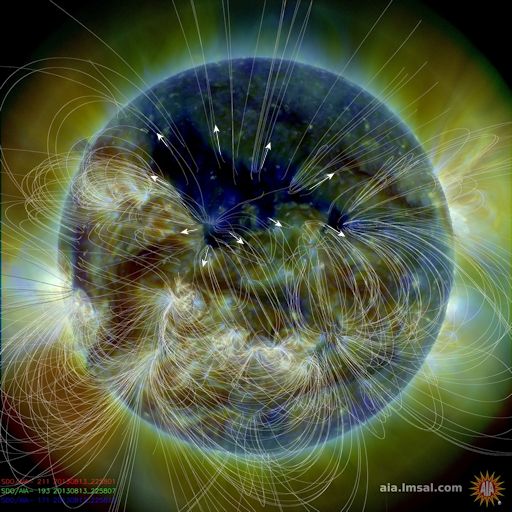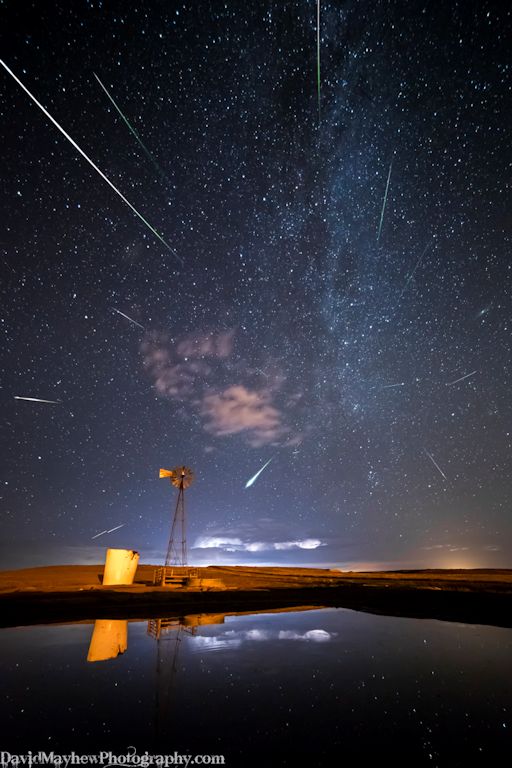They came from outer space--and you can have one! Genuine meteorites are now on sale in the Space Weather Store. | | |
SPACE FENCE, SEQUESTERED: The US Air Force Space Surveillance System, a.k.a. the "Space Fence," will be shut down on Oct. 1st. This is a result of automatic cuts imposed by the US Congressional budget sequester. The Space Fence is a multi-station radar deployed across the southern USA capable of tracking satellites, space debris, and meteoroids as far as 30,000 km from Earth. Readers are asking how this development affects Space Weather Radio, which broadcasts echoes from the Space Fence. Answer: In October we will shift to a new type of meteor radar based on the forward scattering of VHF TV signals.
CORONAL HOLE: A coronal hole has formed in the sun's northern hemisphere, and it is spewing solar wind into space. NASA's Solar Dynamics Observatory photographed the UV-dark gap during the early hours of August 14th:

In the image, above, the sun's magnetic field is traced by white curving lines. The coronal hole is where those magnetic field lines have opened up, allowing solar wind to escape. A stream of solar wind flowing from this coronal hole is expected to reach Earth on August 16-18. NOAA forecasters estimate a 25% chance of polar geomagnetic storms when the windy stream arrives. Aurora alerts: text, voice.
Realtime Space Weather Photo Gallery
PERSEID METEOR SHOWER: The annual Perseid meteor shower is subsiding as Earth exits the debris stream from parent comet 109P/Swift-Tuttle. At its peak on Aug. 12, the shower produced as many as 120 meteors per hour. David Mayhew assembled this composite image of Perseids he saw flying over Pawnee Buttes, CO:

"This is a layered image of the best meteor photos I took on August 12th," says Mayhew. "I used Polaris to rotate the layers in order to match the background star positions. The base layer is a lightning storm from earlier in the night."
Although the shower is subsiding, it's not completely finished. International observers are still counting a dozen or so Perseids every hour between midnight and dawn. If you're out late tonight, look up. A fireball might be in the offing.
Realtime Meteor Photo Gallery
Realtime Aurora Photo Gallery
Realtime Noctilucent Cloud Photo Gallery
[previous years: 2003, 2004, 2005, 2006, 2007, 2008, 2009, 2011]
Realtime Comet Photo Gallery
Potentially Hazardous Asteroids (
PHAs) are space rocks larger than approximately 100m that can come closer to Earth than 0.05 AU. None of the known PHAs is on a collision course with our planet, although astronomers are finding
new ones all the time.
On August 14, 2013 there were potentially hazardous asteroids.
Recent & Upcoming Earth-asteroid encounters: | Asteroid | Date(UT) | Miss Distance | Size |
| 2005 WK4 | Aug 9 | 8.1 LD | 420 m |
| 2013 PS13 | Aug 9 | 0.5 LD | 14 m |
| 1999 CF9 | Aug 23 | 24.7 LD | 1.1 km |
| 2002 JR9 | Aug 31 | 63.5 LD | 1.4 km |
| 2013 PX6 | Sep 21 | 68.6 LD | 1.0 km |
| 1992 SL | Sep 23 | 70 LD | 1.0 km |
| 2000 DK79 | Nov 10 | 49.1 LD | 3.2 km |
Notes: LD means "Lunar Distance." 1 LD = 384,401 km, the distance between Earth and the Moon. 1 LD also equals 0.00256 AU. MAG is the visual magnitude of the asteroid on the date of closest approach. | | The official U.S. government space weather bureau |
| | The first place to look for information about sundogs, pillars, rainbows and related phenomena. |
| | Researchers call it a "Hubble for the sun." SDO is the most advanced solar observatory ever. |
| | 3D views of the sun from NASA's Solar and Terrestrial Relations Observatory |
| | Realtime and archival images of the Sun from SOHO. |
| | from the NOAA Space Environment Center |
| | the underlying science of space weather |

